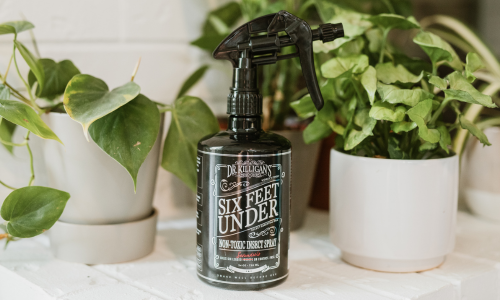Updated on March 28th, 2025
Though small, fruit flies and gnats can quickly turn your home from peaceful to pest-infested. How do you know which one is invading your safe place? And how do you get rid of an infestation?
In this post, we’ll explore the key differences between fruit flies vs. gnats, including appearance, behavior and how to get rid of them.
Fruit fly vs. gnat: How to spot the difference
Though seemingly similar in appearance, fruit flies and gnats both have distinguishing features that allow you to tell them apart. Fruit flies look like a smaller version of a house fly, whereas gnats look like a smaller version of a mosquito.
Still unsure if you’re looking at a fruit fly or a gnat? Use this quick comparison chart to spot the key differences between fruit flies vs. gnats at a glance.
| Feature | Fruit fly | Gnat |
|---|---|---|
| Color | Tan and black (tan front, black rear) | Dark brown |
| Body shape | Oval-shaped, like a smaller version of a house fly | Long and thin, like a tiny bug with long legs |
| Legs | Very short | Long |
| Antennae | Barely perceptible | Lengthy |
| Eyes | Large, prominent, usually red (sometimes brown or black) | Barely detectable |
Fruit flies vs. fungus gnats: Identifying the most common indoor pests

When homeowners spot tiny flying insects indoors, it's natural to wonder: Is this a fruit fly or a gnat? In most cases, if you're dealing with gnats inside, you're likely dealing with fungus gnats.
Fungus gnats are the most common indoor gnat species because they thrive in moist environments—especially the soil of overwatered houseplants and areas with decaying organic matter. Unlike other types of gnats, which typically stay outdoors, fungus gnats are strongly associated with indoor plants and humidity problems.
You'll often spot them hovering around potted plants, crawling on soil or lingering near damp corners and drains.
On the other hand, fruit flies are attracted to fermenting, sugary food sources. You'll usually find them warming around fruit bowls, garbage disposals, empty bottles or any place with food residues. They have a keen sense of smell and can detect fermenting fruit from afar. (Bonus: Fruit flies do not bite.)
Quick tip: If the flying pests are near your plants, think fungus gnat. If they're in your kitchen, think fruit fly.
Why are they swarming? The truth about fruit flies and gnats
Gnats swarm to reproduce. You may see a cluster of male gnats in a sunlit area when you’re on an evening stroll or notice them hovering over a ripple in a stream or a fencepost. Swarm "markers" include objects that contrast with their surrounding landscape, which makes it easier for the females to see their male counterparts.
Fruit flies swarm to eat.In their attraction to sweet, rotting fruits, fruit flies gather to feast. You may see them hovering over brown-spotted bananas, a sink drain, garbage disposal, mop bucket or even a damp sponge.
If you’ve identified which you’re dealing with—fruit flies swarming your kitchen or gnats haunting your houseplants—you can now target them with the most effective solutions.
How to get rid of fruit flies and gnats for good
Fruit flies will not simply disappear on their own. In fact, they’ll do quite the opposite, laying up to 2,000 eggs in their short 15-day lifespan. These eggs, mind you, become egg-laying adult females within two days of birth. Purchase Dr. Killigan's Sweet Surrender, with its powerful handcrafted blend of vinegar, sucrose and citrus, and naturally attract and kill the common fruit fly.

I would also purchase Dr. Killigan’s Six Feet Under, a fruit fly spray that is safe to use in your kitchen. Wipe out the bottom of your fruit bowls with this plant-powered kill-on-contact spray. Use to clean the inside of your garbage can. Spray, rest, repeat. Let Dr. Killigan's do the dirty work.
For gnats: Close your mouth when you’re on a bike ride. (If you speed through a swarm of them, you don’t really want to choke down a few dozen.) In your yard, let them be. They don’t bite and they’re not attracted to you. They’re most likely performing their mating dance. If anything, take a slow sip of your cool drink and be thankful that you don’t have to bounce up and down to get someone’s attention and that you’re going to live more than 7 days.
If you find that the gnats haphazardly make their way indoors (remember that they’re not great fliers), here’s a simple DIY gnats trap to get rid of them:
DIY gnat trap recipe:
- Mix ½ cup of warm water, 2 tablespoons of apple cider vinegar, 1 tablespoon of sugar and about 6 drops of liquid dish soap.
- Pour the mixture into a shallow bowl and stir gently.
- Place the bowl near the gnat-infested area and let it sit.
- Gnats will be lured in by the sweet scent, get trapped by the soap and meet their end. Goodbye, you winged invaders!
Winning the battle
Whether you’re dealing with fruit flies swarming your kitchen or fungus gnats circling your houseplants, identifying them correctly is the first step to kicking them out. With the right knowledge, targeted strategies and trusted tools like Sweet Surrender and Six Feet Under, you’ll be ready to reclaim your home from these tiny invaders.





















